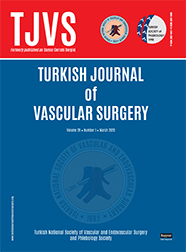
The Turkish Journal of Vascular Surgery
Yazarlar: Ünsal VURAL, Ahmet Arif AĞLAR, Zeynep ASLAN, Ferruh ELBİR, Mehmet KIZILAY, Ahmet Yavuz BALCI, İbrahim YEKELER
Konular:-
Anahtar Kelimeler:Aneurysm; aneurysm,False; peroneal neuropathies; popliteal artery; tibial neuropathy; surgical procedures,Elective; cardiovascular surgical procedures; vascular surgical procedures
Özet: Objective: Amputation is performed in a significant proportion of the cases with popliteal artery aneurysms at diagnosis, and most of the cases are diagnosed in the symptomatic phase. Therefore, we aimed to contribute literature by analyzing early diagnosis, additional vascular pathology (acute or chronic embolism, rupture etc), choice of graft and approach, appropriate graft, appropriate timing and appropriate method, and the impact of these parameters on postoperative complications in popliteal artery aneurysms (PAA). Material and Methods: Thirty-eight of 47 cases who had surgery with the diagnosis of PAA between June 2004 and September 2014 were reviewed retrospectively. Eighty-four percent of the cases were males, and they were examined with acute ischemia, pressure-related pain and intermittent claudication symptoms. Surgery was performed through a posterior approach in 21 cases (55%) and through a medial approach in 17 cases (44.7%) after their demographic and clinical characteristics were considered. Twelve patients (32%) underwent emergency, and 26 patients (68%) underwent elective surgery. A polytetrafluoroethylene (PTFE) graft was used in 16 cases (42%), and a saphenous vein graft was used in 22 cases (58%). Bleeding, thrombosis, neurologic injury, amputation and mortality rates were compared in the early postoperative period. During a follow up period of 12 months, the impacts of choice of graft, approach, type of surgery (emergency or elective) and the additional vascular pathologies on the patency rates of the grafts were analyzed. Results: The demographic and clinical characteristics of the groups in relation with the approach were similar between approaches (p>0.05). Primary graft patency rates were 76% at-1st month and 59% at the 12th month in the medial approach, and they were found as 90% and 86%, respectively in the posterior approach. The graft thrombosis rate was higher, but not significant in the medial approach (p=0.078). There were no significant differences between the rates of complications such as bleeding, infection and venous thrombosis of the groups in relation with the approach (p>0.05). The demographic characteristics of the groups with and without thrombosis were similar (p>0.05). Development of thrombosis was noted in 67% of the cases undergoing emergency surgery in 1 year, and the difference was significant when they were compared with the cases undergoing elective surgery (p<0.05). Primary graft thrombosis developed in 50% of the patients with PTFE graft in 1 year. A significant difference was found when it was compared with saphenous vein graft (p=0.036). Development of thrombosis was noted in 64% of the cases admitted with additional acute embolism in 1 year (p<0.05). The impact of acute embolism on the development of thrombosis was highly significant (p<0.001). Amputation was performed in one of the cases in the medial and posterior approach groups (6% and 5%, respectively). Mortality was not observed. Foot drop was observed in 5 cases (13%) in the posterior approach group, the difference with the medial approach group was not significant (p=0.053). Pseudoaneurysm developed in two cases in the posterior approach group (10%, p=1.00) and in one case in the medial approach group (6%, p=1.00). Conclusion: Although foot drop due to peroneal nerve injury was more common in the posterior approach group since the nerve is in vicinity of the incision line, the rate of graft thrombosis lower. Since posterior approach provides a much better view of the surgical field in the distal end of the anastomosis in popliteal aneurysm surgery, we suppose that it is one of the determinant factors in the rate of thrombosis. Since medial approach provides a much better view of the surgical field in the proximal end of the anastomosis, it should be preferred in the femoropopliteal aneurysm surgery, and determining the approach according to the diameter and localization of the aneurysm will increase the patency rates of the grafts. We think that the graft patency rates would be within acceptable ranges in non-complicated aneurysms diagnosed earlier and treated with autogenous vein graft.